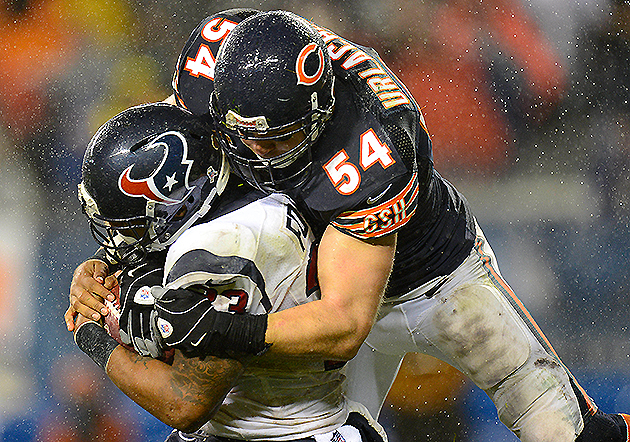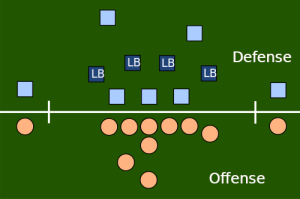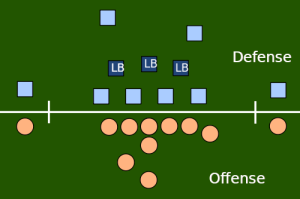In preparation for the rapidly approaching football season, Dear Sports Fan is publishing a series about the basics of football. Some previous posts answer the questions: Why Do People Like Football, How do I Begin to Enjoy Football, Why Are People Obsessing About Fantasy Football Now, and What’s a Down in Football. This post is one in a series that explores each position on a football team. So far we’ve covered What is a Running Back in Football, What is a Quarterback in Football, What is a Defensive Back in Football, What is a Wide Receiver in Football, and What is a Defensive Lineman in Football. Today we finish up the defensive side of the ball with What is a Linebacker in Football?
What is a Linebacker in Football?
Linebackers are the meanest, toughest football players on the field. At least, they look it. Unlike linemen, who have a little extra meat on their bones to help them move the player across from them, linebackers are usually sculpted like extras in 300. They’re stronger than defensive backs and faster and more agile than defensive linemen. They line up a few yards behind the line of scrimmage and are responsible both for crashing the line of scrimmage to stop a running back or sack the quarterback and for covering tight ends or wide receivers, generally when those offensive players are sent running to catch a pass on shorter (“underneath”) routes.
The greatest linebackers are those that can play “sideline to sideline” – they can cover huge amounts of ground and are fast enough, for example, to keep up with a running back who is trying to get around the defense. They are also equally skilled at stopping the run and covering receivers, which means they don’t have to come off the field in situations when the defense thinks the opposing offense is more likely to pass or run.
When the ball is snapped linebackers may have any number of responsibilities: if it’s a running play they may attack the line of scrimmage aggressively, trying to get through to get the ball carrier in the backfield; or, they may slide side to side, mirroring the running back’s movements and containing him by plugging the holes the offensive linemen are trying to create.
If it’s a pass play, the linebacker may cover a tight end in man to man coverage, or be responsible for covering whoever crosses into a specific zone of the field; or, they may be assigned to blitz, ignoring everything else for a chance to hit the quarterback in the backfield before he can release the ball.
There can be anywhere from one to four linebackers on the field in any given situation. Although we covered the two most common defensive formations in the defensive lineman post, it’s worth repeating:
A total of seven defensive players play near the offensive line in both of these formations. Players who usually start a play in a sprinter’s stance right on the line of scrimmage are defensive linemen, and players who start standing up (usually a few feet to a few yards back from the line of scrimmage) are called linebackers. A 4-3 defense plays with four linemen and three linebackers. A 3-4 defense plays with three linemen and four linebackers.
Unlike defensive linemen, linebacker positions and responsibilities between 3-4 and 4-3 formations are not so incredibly different. The key difference is between middle and outside linebackers.
Middle or inside Linebackers
The middle or inside linebackers are the quarterbacks of the defense. Particularly in a 4-3 defense when there is only one of them (as opposed to 3-4 when there are two,) they are expected to be the leader of the defense. In our quarterback post we mentioned that the quarterback is the one player on the offense who has a ear-piece in his helmet that allows him to hear his coach between plays. On defense the ear-piece can be in any player’s helmet but it is most frequently in a middle linebacker’s helmet. You can tell who has the ear-piece because they have a little green dot on the outside of their helmet.
A middle linebacker who leads the defense this way gives the rest of the defensive players their assignments, checks out the offensive formation and makes any last-second adjustments before the ball is snapped.
Since they’re positioned in the middle of the field they usually are responsible for covering more ground so they have to be fast. Since they’re positioned in the middle of the field they are also usually involved in more plays… which means more collisions so they have to be strong. Since on top of all of this they also have to be leaders, they tend to be loud, brash, spilling over with charisma.
Outside LINEBACKERS
Outside linebackers, by contrast, may be limited to covering their half of the field. For example, if a running back takes a hand-off and runs to the defense’s left, the middle and left outside linebackers’ jobs will likely be to fly to the ball and try to bring the ball carrier down. The right outside linebacker’s job, on the other hand, may be to stay on his side of the field, lagging a little behind the play, to make sure the running back can’t reverse direction and get around the defense.
Outside linebackers are also well-positioned to blitz the quarterback, since it’s frequently easier to penetrate the outside of the offensive line than it is to get through the middle. Outside linebackers tend to be slightly smaller and quicker than inside linebackers just like defensive ends are smaller and quicker than defensive tackles and for pretty much the same reason. In both common formations but particularly in a 4-3 defense, the outside linebackers are among the players with the best chance to tackle the quarterback before he can throw the ball to a receiver.
Although they are all linebackers, outside linebackers vary from their inside cousins when it comes to personality. Outside linebackers, because they usually don’t bear the burden of leading the defensive team, and because they have rare talent and can specialize in making explosive plays, tend to be a little more eccentric, sometimes to the point of erraticism. Lawrence Taylor is an extreme example of this. In the 1980s Taylor revolutionized the way outside linebackers played by being faster, stronger, more aggressive, and less predictable than anyone had ever been. He kept quarterbacks and offensive linemen from sleeping the night before they had to face him. He was also a bit crazy. On his Wikipedia page there is a section titled “Drugs and Extreme Measures” and it includes the words crazy, wild, reckless, abandon, aberrant, and controversy.



